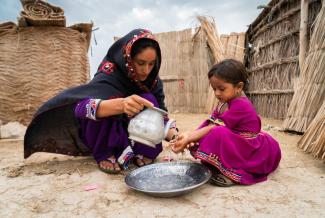Water
**COVID-19 specific information**
In some contexts, lack of access to running water can be a constraint to the implementation of this basic action, especially for the most vulnerable people, including people with disabilities. Here are a few ways of mitigating this problem:
- organize the distribution of containers that can facilitate hand washing

- set up installations made locally with local materials, installations that meet the principles of universal design (appropriate height for wheelchair users, handles accessible to all, access path, brightly markings around the installation, etc.)

*****************************************
Access to clean water is fundamental in an emergency context. Being dependent on others for accessing water resources for drinking, sanitation, hygiene or irrigation, can be unsafe and result in harmful personal consequences.
Access to water and sanitation facilities, which comprise toilets, closed showers, washing areas are basic needs for everyone. Sexual abuse, financial exploitation and deteriorating health consequences are only a handful of challenges women, men, including older people, girls and boys with disabilities may face because of often not having full access to water resources.
Furthermore, lack of access to water resources can limited the ability to join public spaces and participate to community activities and social events.
In emergency set-up, access to safe water can be facilitated by activities that are quite easy to implement, if correctly planned in advance: accessibility of well, handpump, washroom need to be budgeted from the very beginning of the response.